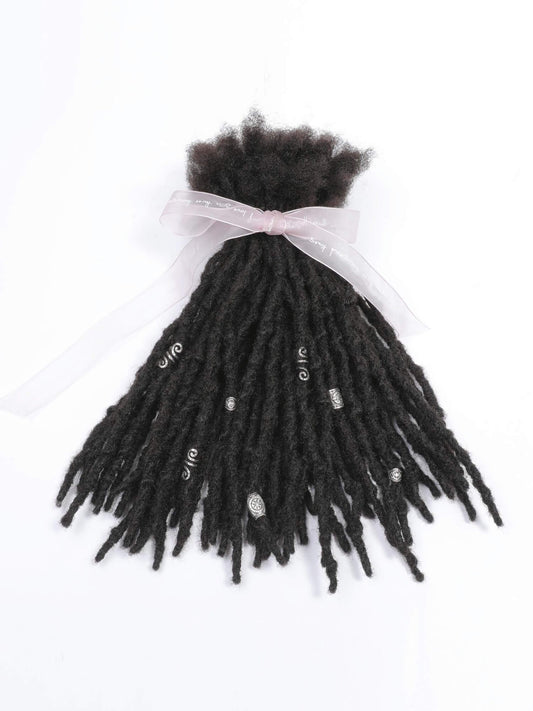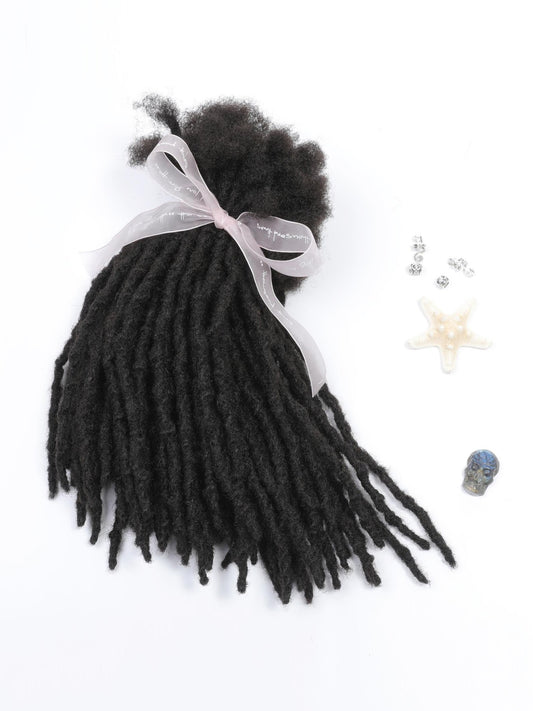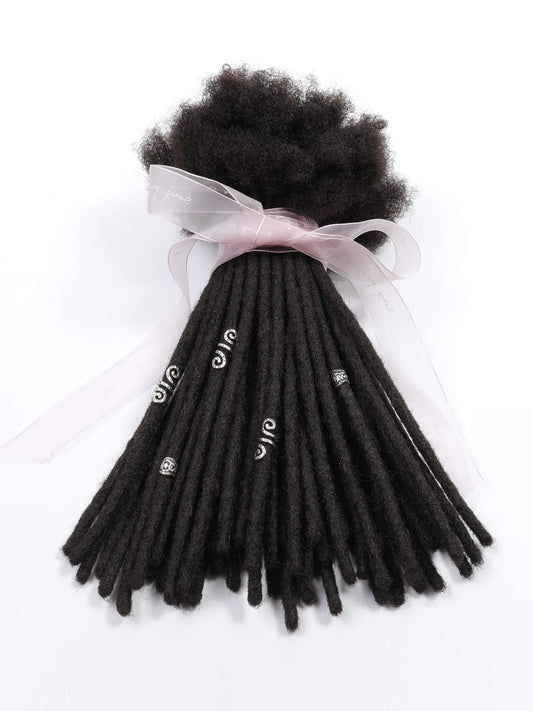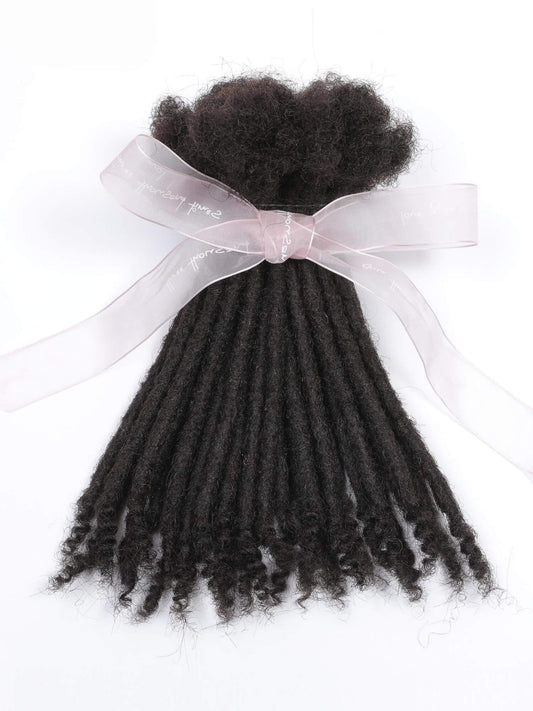Dreadlock journey is not easy to start for everyone, especially for people with thin hair textures. Different individuals have different types of hair that are a unique combination of genetics and adaptations over the life stages.
Individuals with thin hair might think they cannot get the dreads because their hair is so thin that it may not hold the locs. But, the fact is that starter locs on thin hair result in a unique style that appeals to everyone. Once the starter locs grow, it is not tough to get the original locs.
Having locs with fine hair means you will have more significant revealing sections of hair. So, make sure to look for the possibilities that can help. In the locs journey, hair density is one factor that varies in different scalp areas. So, it is quite challenging to start the locs while balancing the sections of dreads so that they get a uniform size and distribution. Thin hair usually ends up with fewer dreads, such as 20 or 30, depending on the hair volume. So, one must consider the dreadlock extensions to cover these areas on the scalp.
If you are someone who has thin hair and looking for means to get the locs, this is the guide for you. In this blog, we will share a guide about things to consider for locs journey on soft hair? Plus, which methods are best while getting locs on light hair and much more. So, keep reading to learn more about locs for thin hair.
Fine hair vs. Thin hair
First, you must know if you have thinning or fine hair. Both these types of hair are different. The hair per square inch denotes your hair, varying from person to person. It also varies in multiple head sections directly proportional to your scalp. This is the hair density that one contains in a certain head section.
Before starting the locs in thin hair, it is essential to know if you already have fine hair from day one or are losing or experiencing hair thinning due to underlying reasons. Many people have a misconception that locs installation causes thinning of hair. That is a myth. So, treating fine hair is necessary first and then starting the locking process.
Find a Loctician Who is Known for Thin Hair Locs Installation
The first step of starting the locs with fine hair is to find a true professional who knows well about the hair type and how to manage them. Installing locs in thin hair can be problematic because the locking may reveal the bald patches on the scalp. But, a professional with prior experience installing the locs in thin hair can cover your head professionally without revealing the scalp.
In addition, the services of a professional make him the hero of your styling journey depending upon your hair type, locs size, and parting style selection. As locking is a permanent hairstyle, you must serve enough time searching for the best person in your hometown. Get in contact with your friends who have locs and ask for the best locticians. Research on the search engines and read the reviews and then approach. Discuss your hair type and related concerns before starting the locs journey.
Further, some individuals with fine hair with color must approach the loctician to find out the possible issues that can occur after locs installation. It will help them complete knowledge about the pros and cons of the process. So, it will be easier to consider their decision of locs installation in soft hair.
Parting System for Thin Hair Locs
Parting system selection is the next step in starting any locs for any hair type. Different parting systems are designed for different locking styles and hair types, and it is essential to consult with the loctician and finalize the right parting style. When starting the locs in thin hair, understand that the parting system is vital because it determines the size you want your locs to be.
In the beginning, when the locs are installed, they are small, but the locs accumulate and swell up over time. The locs become thick and increase the overall hair volume. So, your locs started must not be the size you want because starting with a small size can be suitable for the fine locs.
For thin locs, diamond parting is an ideal choice. A diamond parting system allows you not to have much scalp shown, which is a common problem for people with thin hair. You must be familiar with the parting system. So, make sure you consult a professional who is well aware of the parting systems, and you have different choices. Choose the parting system according to your hair type, density, and desired results. Further, you may know that you can’t comb out the locs, and you cannot cut or repart your parting system.
Best Locking Technique for Thin Hair Locs
The next step of starting the locs for thin hair is the right technique for locs installation. Different locticians perform techniques such as free form, double-strand, or more according to their client’s hair type. So, the better thing is to consult your loctician or hair professional and get the analysis done. You can present your concerns and get the answers. According to the research, the two locs installation methods are perfect for people with thin hair.
1: Two twist strands
For thin and fine hair, starting locs with two-strand twists is an ideal choice. It is one of the popular techniques of starting the locs that is performed by parting into two small sections and then twisting the two hair strands just like the rope-like appearance. One of the benefits of starting locs in thin hair with two twist strands is that it is convenient to start and provides maximum protection from hair breakage. Further, the style is versatile and easily managed at college, office, and work. Being unique in its appearance, it requires no further hair setting or styling and gives you a new and transformed look. Additionally, adding the Afro-kinky human hair to the natural hair in the form of extensions is an excellent idea to give a fuller look. Plus, it will provide length and stability to thin hair and hides your bold patches.
2: Interlocking
Another technique for starting the locs is the interlocking technique. It is also known as the latch-hooking or root flipping technique. It creates the baby locs, which hold the hair in that position while the dreads form. It is well-renowned for starting the locs in thin hair because it can be performed in soft hair conveniently. Start the locking by interlocking at the roots and creating small braids towards the ends to prevent unraveling.
Start the locs with either technique and take care of them. Don’t forget to get the hair extensions around the nape area and the edges because the hair can often be more vulnerable to breakage at these points. After locs installation in fine hair, it is essential to keep them well-moisturized. For this purpose, you can add a little oil to your palm and massage it on the locs and scalp.
Number of Locs in Thin Hair
Getting all-natural locs with thin hair can reveal some scalp patches, which can be covered with locs extensions. If you want to cover your scalp and get a fuller look, locs installation is a good thought. The number of locs installed depends on various factors, including the hair's texture. If you have thin hair, you must add fewer hair extensions that the thin hair can quickly help.
For people with thin hair, going above 50 locs is good, and they can easily install 50 top 70 locs with thin hair without adding extra tension and stress on the scalp. Further, the size of the locs must be checked as the thin hair has a minor diameter, so select the locs pack with a small diameter as well. Hair loctician can guide you in a better way about the number and diameter of locs installation.
Starter Locs with Thin Hair Maintenance
People think getting the locs is relatively easy, but the fact is that installing the locs is just one step. Keeping the locs well maintained is the real challenge. So many things need attention while having dreads with thin hair.
Washing:
Washing the locs is a sensitive matter, especially for thin hair. Thin hair is light in texture, breaks easily, and washing leaves the hair in the hands. So, it is not suggested to wash the dreads more than twice a month. Frequent washing of the dreads is not beneficial for the overall condition of hair dreads.
Cleaning:
Keeping the dreads clean can be very challenging when people are sports freaks, and heavy exercises result in excessive sweating that results in a potential buildup. So, combing the dreads daily or avoiding such activities resulting in buildup is essential. Further, detoxing the dreads once a year using a deep cleaning method is also a good option.
Buildup:
The buildup is another challenge while maintaining the thin hair locs. Most of the time, people don’t care for locs as they care for loose natural hair. As a result, locs get the buildup very quickly. So you ought to dodge the buildup by utilizing hair care products such as residue-free shampoo, conditioner, and more. In addition, try to stick to organic products that don’t leave any buildup, such as butter, oils, lightweight moisturizers, and water.
To sum up, thin hair locs are more challenging to deal with, and they need extra attention in hair care and maintenance. On the other hand, locs on fine natural hair are undoubtedly a significant transformation to get away with the dull look. In addition, the hair locs extensions can add to your style if you have extremely thin hair. Hopefully, this guide will help you visit the loctician to get the locs in your thin hair.





1 comment
Help finding a professional loc stylist in the Maryland / DC area